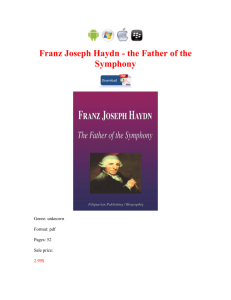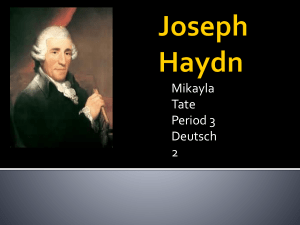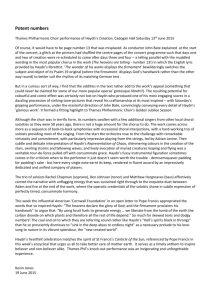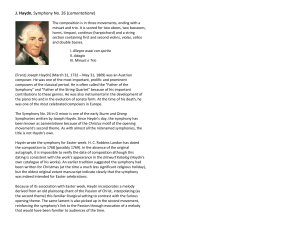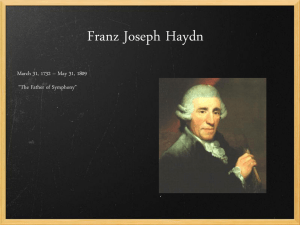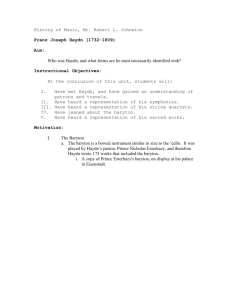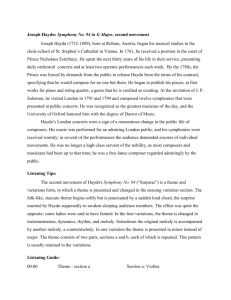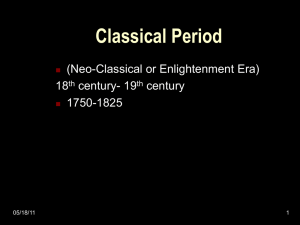Joseph Haydn Biography.rev
advertisement
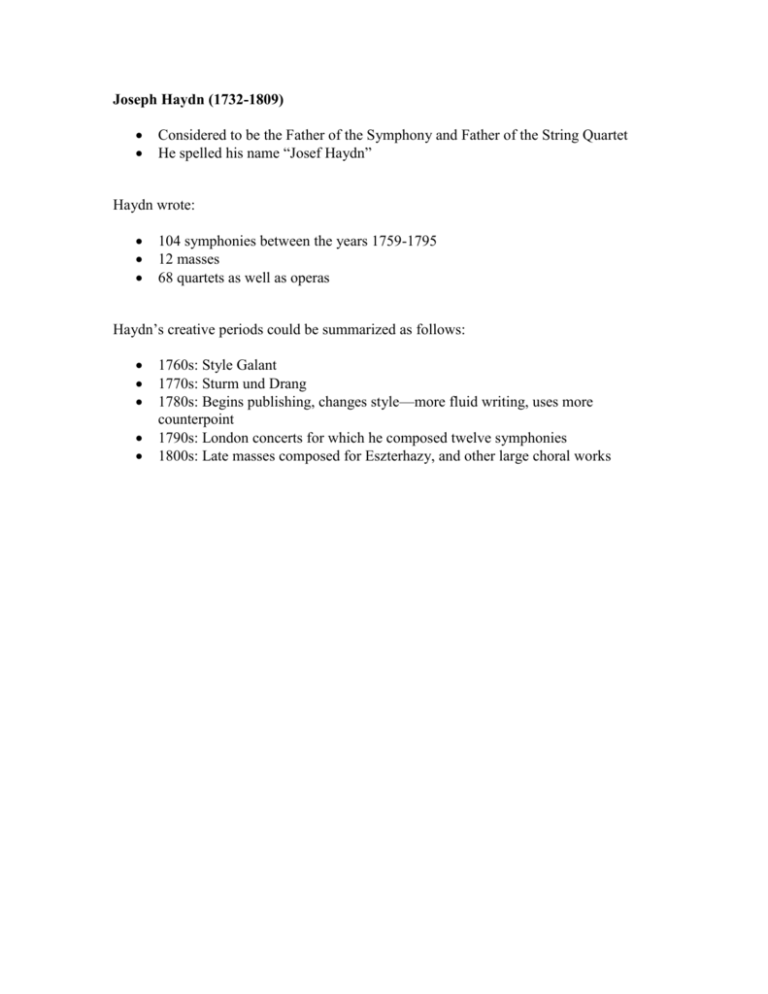
Joseph Haydn (1732-1809) Considered to be the Father of the Symphony and Father of the String Quartet He spelled his name “Josef Haydn” Haydn wrote: 104 symphonies between the years 1759-1795 12 masses 68 quartets as well as operas Haydn’s creative periods could be summarized as follows: 1760s: Style Galant 1770s: Sturm und Drang 1780s: Begins publishing, changes style—more fluid writing, uses more counterpoint 1790s: London concerts for which he composed twelve symphonies 1800s: Late masses composed for Eszterhazy, and other large choral works Childhood and Family Background (1732-1749) Father, Matthais, was a wheelwright and mayor of Rohrau, an Austrian village. Father was also a enthusiastic folk musician Brother, Michael Haydn, was a composer, and Johann Evangelist Haydn, a tenor Josef was apprenticed in his childhood to a local musician. He sang in the church choir and learned harpsichord and violin. He was poorly cared for and often hungry In 1740, he came to the attention of Georg von Reutter, the director at St. Stephen’s Cathedral in Vienna In 1749, he was dismissed from St. Stephen’s because his voice changed Years of Study (1749-59) 10 years of apprenticeship and study followed. Josef worked as a valet and accompanist for Nicola Porpora, the Italian opera composer from whom he learned the fundamentals of music Wrote his first string quartets and an opera Posts (1759-1791—dates are variously reported) First post for Count Karl von Morzin; Morzin suffered financial losses and had to dismiss his musical establishment In 1761, Haydn became assistant Kapellmeister to the Eszterhazy Family. The Eszterhazys were one of the wealthiest and most important families in Austrian Empire. Haydn became full Kapellmeister in 1766 upon the death of Gregor Werner, his predecessor The Eszterhazys maintained three residences: Eisenstadt, the Winter Palace in Vienna, and the new Palace built in Hungary around 1760. Haydn’s first employer was Paul Anton, who was succeeded by Nikolaus I Haydn’s duties included chamber music (especially baryton trios), orchestral concerts, and opera Haydn married Maria Anna Keller. She was the sister of the woman he actually fell in love with, but she married someone else. It was an unhappy and childless marriage. Haydn likely had a long-term love affair with Luigia Polzelli, a singer at Court with whom he probably had children. By the mid 1780s, Haydn’s fame had transcended Eszterhazy. Two notable groups of works from this period are the Paris symphonies, and “The Seven Last Words of Christ”, which composed for the Good Friday Service at the Grotto Santa Cueva near Cadiz, Spain. In 1781, Haydn established a friendship with Mozart. They played chamber music together, and Mozart dedicated six string quartets to Haydn (unusual at the time) Haydn also established a platonic friendship with Maria Anna von Genzinger, wife of Prince Nikolaus’s personal physician. His correspondence to her reveals his loneliness and isolation at Eszterhazy, and her premature death on 1793 was a deep blow to him, reflected in the Piano Variations, Hob. XVII:6 Vienna, first years, and the London Visits Nikolaus died in 1790 and was succeeded by his son Nikolaus II, as unmusical a man as is brother was musical Nikolaus II dismissed the orchestra and put Haydn on pension Haydn met Beethoven in Vienna and gave the young composer lessons. Johann Peter Salomon, a German impresario and orchestra leader in London, commissioned twelve symphonies, performed over two extended visits, 1791-92, and 1794-95. Among these works are the Surprise, Military, Drumroll, Miracle, and London symphonies These performances were heralded in the press as the most important musical events in London. Haydn quickly became both rich and famous Final Years Haydn declined subtle invitations from George III to remain in England and returned to Vienna. He had a large home built and turned to writing large-scale religious choral works. Haydn composed six masses and two great oratorios (Creation, The Seasons) for the Eszterhazy family, these written at the request of Nikolaus II’s successor. Serious illness began in 1802 which made it difficult for him to compose. Died in 1809 during the Napoleonic attack on Vienna. Sonata Form in Haydn’s hands Introduction: Haydn often employed a slow introduction. The material is usually not related to the main Allegro, but can be (notable exception: the “Drumroll” Symphony, in which the Introduction actually returns before the coda). Exposition: Haydn’s expositions often use the first theme at the arrival of the contrasting key. “Monothematic” is a misnomer, since these expositions had numerous thematic ideas Development: rapidly shifting keys, contrapuntal textures, false reprises Recapitulation: Unlike Beethoven and Mozart, Haydn may shift the order of the material or provide unusual key treatments. For example, Symphony 95, in C minor, modulates to C Major for the second theme, and ends in major Coda: sometimes Haydn uses extended codas. This trait is picked up by Beethoven.
